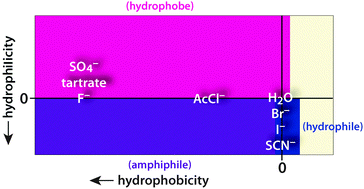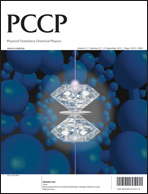1-Propanol probing methodology: two-dimensional characterization of the effect of solute on H2O†
Abstract
The wording “hydrophobicity/hydrophilicity” has been used in a loose manner based on human experiences. We have devised a more quantitative way to redefine “hydrophobes” and “hydrophiles” in terms of the mole fraction dependence pattern of one of the third derivative quantities, the enthalpic interaction between solute molecules. We then devised a thermodynamic methodology to characterize the effect of a solute on H2O in terms of its hydrophobicity and/or hydrophilicity. We use a thermodynamic signature, the enthalpic interaction of 1-propanol, HE1P1P, to monitor how the test solute modifies H2O. By this method, characterization is facilitated by two indices; one pertaining to its hydrophobicity and the other its hydrophilicity. Hence differences among amphiphiles are quantified in a two-dimensional manner. Furthermore, an individual ion can be characterized independent of a counter ion. By using this methodology, we have studied the effects on H2O of a number of solutes, and gained some important new insights. For example, such commonly used examples of hydrophobes in the literature as tetramethyl urea, trimethylamine-N-oxide, and tetramethylammonium salts are in fact surprisingly hydrophilic. Hence the conclusions about “hydrophobes” using these samples ought to be interpreted with caution. The effects of anions on H2O found by this methodology are in the same sequence of the Hofmeister ranking, which will no doubt aid a further investigation into this enigma in biochemistry. Thus, it is likely that this methodology could play an important role in the characterization of the effects of solutes in H2O, and a perspective view may be useful. Here, we describe the basis on which the methodology is developed and the methodology itself in m.ore detail than given in individual papers. We then summarize the results in two dimensional hydrophobicity/hydrophilicity maps.


 Please wait while we load your content...
Please wait while we load your content...